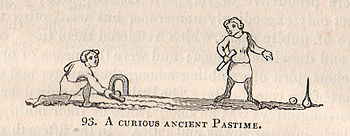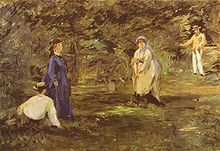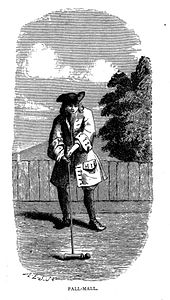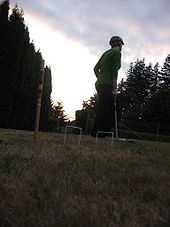- Croquet
-
This article is about the game. For the food; item, see Croquette. For the Smalltalk-based 3D software platform, see Croquet project.
 Winslow Homer: Croquet, 1864
Winslow Homer: Croquet, 1864
Croquet is a lawn game, played both as a recreational pastime and as a competitive sport. It involves hitting plastic or wooden balls with a mallet through hoops (often called "wickets" in the US) embedded into the grass playing court.
Contents
History
The oldest document to bear the word "croquet" with a description of the modern game is the set of rules registered by Isaac Spratt in November 1856 with the Stationers' Company in London. This record is now in the English Public Records Office. In 1868 the first croquet all-comers' meeting was held at Moreton-in-Marsh, Gloucestershire and in the same year the All England Croquet Club was formed at Wimbledon, London.
In the book Queen of Games: The History of Croquet[1] author Nicky Smith presents two theories of the origin of the modern game that took England by storm in the 1860s and then spread overseas.
The first explanation is that the ancestral game was introduced to Britain from France during the reign of Charles II of England, and was played under the name of paille maille or pall mall, derived ultimately from Latin words for "ball and mallet". This was the explanation given in the ninth edition of Encyclopaedia Britannica, dated 1877. In his 1810 book entitled "The sports and pastimes of the people of England," Joseph Strutt describes the way Pall Mall was played in England in the early 17th century: "Pale-maille is a game wherein a round box ball is struck with a mallet through a high arch of iron, which he that can do at the fewest blows, or at the number agreed upon, wins.' It is to be observed, that there are two of these arches, that is one at either end of the alley. The game of mall was a fashionable amusement in the reign of Charles the Second, and the walk in Saint James's Park, now called the Mall, received its name from having been appropriated to the purpose of playing at mall, where Charles himself and his courtiers frequently exercised themselves in the practice of this pastime[2][3]
Whilst the name Pall Mall and various games bearing this name may have been played elsewhere (France and Italy) the description above suggests that the croquet games were certainly popular in England as early as 1611. Some early sources refer to Pall Mall being played over a large distance (as in golf), however an image in Joseph Strutt's 1801 book The Sports and Pastimes of the People of England clearly shows a croquet like game (balls on ground, hoop, bats and peg) being played over a short (garden sized) distance. Interestingly, this image describes the game as 'A curious ancient pastime', confirming that croquet games were not new in early nineteenth century England.
 Early croquet game from The Sports and Pastimes of the people of England, first published 1801. Hoop, peg and two players with balls clearly shown.
Early croquet game from The Sports and Pastimes of the people of England, first published 1801. Hoop, peg and two players with balls clearly shown.
In Samuel Johnson's 1828 dictionary, his definition of "Pall mall" clearly describes a game with similarities to modern croquet: "A play in which the ball is struck with a mallet through an iron ring".[4] However, there is no evidence that Pall Mall involved the croquet stroke which is the distinguishing characteristic of the modern game.
The second theory is that the rules of the modern game of croquet arrived from Ireland during the 1850s, perhaps after being brought there from Brittany where a similar game was played on the beaches. Records show the similar game of "crookey" being played at Castlebellingham in 1834, which was introduced to Galway in 1835 and played on the bishop's palace garden, and in the same year to the genteel Dublin suburb of Dun Laoghaire (then Kingstown) where it was first spelt as "croquet".[5] There is, however, no pre-1858 Irish document that describes the way game was played, in particular there is no reference to the distinctive croquet stroke.[6]
A game of Croquet being played at Eglinton Castle, North Ayrshire, in the early 1860s.
John Jaques, apparently claimed in a letter to Arthur Lillie in 1873 that he had himself seen the game played in Ireland and, "I made the implements and published directions (such as they were) before Mr Spratt [mentioned above] introduced the subject to me". Whatever the truth of the matter, Jaques certainly played an important role in popularising the game, producing editions of the rules in 1857, 1860, and 1864.
Regardless when and by what route it reached England and the British colonies in its recognizable form, croquet is, like pall mall, trucco, jeu de mail and kolven, clearly a derivative of ground billiards, which was popular in Western Europe back to at least the 14th century, with roots in classical antiquity.[7][8][9]
Croquet became highly popular as a social pastime in England during the 1860s; by 1867, Jaques had printed 65,000 copies of his Laws and Regulations of the game. It quickly spread to other Anglophone countries, including Australia, Canada, New Zealand, South Africa, and the United States. No doubt one of the attractions was that the game could be played by both sexes; this also ensured a certain amount of adverse comment.
By the late 1870s, however, croquet had been eclipsed by another fashionable game, tennis, and many of the newly-created croquet clubs, including the All-England club at Wimbledon, converted some or all of their lawns into tennis courts. There was a revival in the 1890s, but from then onwards, croquet was always a minority sport, with national individual participation amounting to a few thousand players. The All England Lawn Tennis and Croquet Club still has a croquet lawn, but has not hosted any significant tournaments. The English headquarters for the game is now in Cheltenham.
Captain Moreton's Eglinton Castle croquet
The earliest known reference to croquet in Scotland is the booklet called The Game of Croquet, its Laws and Regulations which was published in the middle 1860’s for the proprietor of Eglinton Castle, the Earl of Eglinton. On the page facing the title page is a picture of Eglinton Castle with a game of "croquet" in full swing.[10]
The croquet lawn existed on the northern terrace, between Eglinton Castle and the Lugton Water. The 13th Earl developed a variation on croquet named 'Captain Moreton's Eglinton Castle Croquet', which had small bells on the eight hoops 'to ring the changes', two pegs, a double hoop with a bell and two tunnels for the ball to pass through. In 1865 the 'Rules of the Eglinton Castle and Cassiobury Croquet' was published by Edmund Routledge. Several incomplete sets of this form of croquet are known to exist, and one complete set is still used for demonstration games in the West of Scotland.[10] It is not known why the earl named the game thus.[11]
Competitive croquet
There are several variations of croquet currently played, differing in the scoring systems, order of shots, and layout (particularly in social games where play must be adapted to smaller-than-standard playing courts). Two forms of the game, association croquet and golf croquet, have rules that are agreed internationally and are played in many countries around the world. The United States has its own set of rules for domestic games. More unusual variations of the game include mondo croquet, extreme croquet, and bicycle croquet (perhaps influenced by polo). Gateball, a sport originated in Japan under the influence of croquet, is played mainly in East and Southeast Asia and the Americas, it can also be regarded as a croquet variant.
As well as club-level games, there are regular world championships and international matches between croquet-playing countries. The sport has particularly strong followings in the UK, US, New Zealand and Australia; every four years, these countries play the MacRobertson Shield tournament. Many other countries also play. The current world rankings[12] show England in top place for association croquet, followed by Australia and New Zealand sharing second place, with the United States in fourth position; the same four countries appear in the top six of the golf croquet league table, below Egypt in top position, and with South Africa at number five.
Croquet is popularly believed to be viciously competitive.[13] This may derive from the fact that (unlike in golf) players will often attempt to move their opponents' balls to unfavourable positions. However, purely negative play is rarely a winning strategy: successful players (in all versions other than golf croquet) will use all four balls to set up a break for themselves, rather than simply making the game as difficult as possible for their opponents. At championship-standard association croquet, players can often make all 26 points (13 for each ball) in two turns.
Croquet was an event at the 1900 Summer Olympics and roque, an American variation on croquet, an event at the 1904 Summer Olympics.
Association croquet
Association croquet is the name of an advanced game of croquet, played at international level. It involves four balls teamed in pairs, with both balls going through every hoop for one pair to win. The game's distinguishing feature is the "croquet" shot: when certain balls hit other balls, extra shots are allowed. The six hoops are arranged three at each end of the court, with a centre peg.
In association croquet one side takes the black and blue balls, the other takes red and yellow. At each turn, the player can choose to play with either of his balls for that turn. At the start of a turn, the player plays a stroke. If the player either hits the ball through the correct hoop ("runs" the hoop), or hits another ball (a "roquet"), the turn continues. Following a roquet, the player picks up his or her own ball and puts it down next to the ball that it hit. The next shot is played with the two balls touching: this is the "croquet stroke" from which the game takes its name. After the croquet stroke, the player plays a "continuation" stroke, during which the player may again attempt to make a roquet or run a hoop. Each of the other three balls may be roqueted once in a turn before a hoop is run, after which they become available to be roqueted again. The winner of the game is the team who completes the set circuit of six hoops (and then back again the other way), with both balls, and then strikes the centre peg (making a total of 13 points per ball = 26).
Good players may make "breaks" of several hoops in a single turn. The best players may take a ball round a full circuit in one turn. "Advanced play" (a variant of association play for expert players) gives penalties to a player who runs certain hoops in the same turn; feats of skill such as triple peels or better, in which the partner ball (or occasionally an opponent ball) is caused to run a number of hoops in a turn by the striker's ball help avoid these penalties.
A handicap system ('bisques') provides less experienced players a chance of winning against more formidable opponents. Players of all ages and both sexes compete on level terms.
As of May 2009, the Association Croquet World Champion is Reg Bamford of South Africa. The World Championships are organised by the World Croquet Federation (WCF)[14] and usually take place every 2 or 3 years. The next World Championship is to take place in April 2012 in Adelaide, Australia.[15] The Great Britain team won the last MacRobertson International Croquet Shield tournament, which is the major international test tour trophy in association croquet. It is contested every 3 to 4 years between Australia, Great Britain, the United States and New Zealand. Historically the British have been the dominant force, winning 14 times out of the 20 times the event has been held. In individual competition, the UK is often divided by subnational country (England, Scotland, Wales and so on.)
The world's top 10 association croquet players as of October 2011 are Reg Bamford (South Africa), Robert Fletcher (Australia), Robert Fulford (England), David Maugham (England), Paddy Chapman (New Zealand), Greg Bryant (New Zealand), Jamie Burch (England), Stephen Mulliner (England), James Death (England), and Ed Duckworth (England).[16]
Unlike most sports, men and women compete and are ranked together. Three women have won the British Open Championship: Lily Gower in 1905, Dorothy Steel in 1925, 1933, 1935 and 1936, and Hope Rotherham in 1960. While male players are in the majority at club level in the UK, the opposite is the case in Australia and New Zealand. The highest-ranked female player in the world as of September 2011 is Jenny Clarke of New Zealand.[17]
The governing body in England is The Croquet Association, which has been the driving force of the development of the game. The rules and tournament regulations are now maintained by the International Laws Committee, established by the croquet associations of England and Wales (CA), Australia (ACA), New Zealand (CNZ) and the United States (USCA).
Golf croquet
In golf croquet a hoop is won by the first ball to go through each hoop. Unlike Association Croquet, there are no additional turns for hitting other balls.
Each player takes a stroke in turn, each trying to hit a ball through the same hoop. The sequence of play is blue, red, black, yellow. Blue and black balls play against red and yellow. When a hoop is won, the sequence of play continues as before. The winner of the game is the player/team who wins the most hoops.
Golf croquet is the fastest-growing version of the game,[18] owing largely to its simplicity and competitiveness. Egyptian players dominate the game.[19] Golf croquet is easier to learn and play, but requires strategic skills and accurate play. In comparison with association croquet, play is faster and balls are more likely to be lifted off the ground, as seen in this video footage.
As of 2011, the Golf Croquet World Champion is Mark McInerney (Ireland). As of 2010, the Women's Golf Croquet World Champion is Alix Verge (Australia).[20]
American six-wicket croquet
The American rules version of croquet – another six-hoop game – is the dominant version of the game in the United States and is also widely played in Canada. It is governed by the United States Croquet Association. Its genesis is mostly in association croquet, but it differs in a number of important ways that reflect the home-grown traditions of American "backyard" croquet.
Two of the most notable differences are that the balls are always played in the same sequence (blue, red, black, yellow) throughout the game, and that a ball's "deadness" on other balls is carried over from turn to turn until the ball has been "cleared" by scoring its next hoop. Tactics are simplified on the one hand by the strict sequence of play, and complicated on the other hand by the continuation of deadness. A further difference is the more restrictive boundary-line rules of American croquet.[21]
In the American game, roqueting a ball out of bounds or running a hoop out of bounds causes the turn to end, and balls that go out of bounds are replaced only nine inches from the boundary rather than a yard as in association croquet.[21] "Attacking" balls on the boundary line to bring them into play is thus far more challenging.
Glossary of croquet terms
- Backward ball: The ball of a side that has scored fewer hoops (compare with 'forward ball').[22]
- Ball-in-hand: A ball that the striker can pick up to change its position, for example:
-
- any ball when it leaves the court has to be replaced on the yard-line
- the striker’s ball after making a roquet must be placed in contact with the roqueted ball
- the striker’s ball when the striker is entitled to a lift.[23]
- Ball in play: A ball after it has been played into the game, which is not a ball in hand or pegged out.[23]
- Baulk: An imaginary line on which a ball is placed for its first shot in the game, or when taking a lift. The A-baulk coincides with the western half of the yard line along the south boundary; the B-baulk occupies the eastern half of the north boundary yard line.[23]
- Bisque, half-bisque A bisque is a free turn in a handicap match. A half-bisque is a restricted handicap turn in which no point may be scored.[23]
- Break down: To end a turn by making a mistake.[22]
- Continuation stroke: Either the bonus stroke played after running a hoop in order or the second bonus stroke played after making a roquet.[23]
- Croquet stroke: A stroke taken after making a roquet, in which the striker's ball and the roqueted ball are placed together in contact.[23]
- Double-banking: Playing two games on one croquet lawn at once. One game uses the secondary colours: green and brown versus pink and white.[23]
- Double tap: A fault in which the mallet makes more than one audible sound when it strikes the ball.[23]
- Forward ball: The ball of a side that has scored more hoops (compare with 'backward ball').[22]
- Hoop: Metal U-shaped gate pushed into ground.[23] (Also called a wicket in the US).[citation needed]
- Leave: The position of the balls after a successful break, in which the striker is able to leave the balls placed so as to make life as difficult as possible for the opponent.[22]
- Lift: A turn in which the player is entitled to remove the ball from its current position and play instead from either baulk line. A lift is permitted when a ball has been placed by the opponent in a position where it is wired from all other balls, and also in advanced play when the opponent has completed a break that includes hoops 1-back or 4-back.[23]
- Object ball: A ball which is going to be rushed.
- Peg out: To cause a rover ball to strike the peg and conclude its active involvement in the game.[23]
- Peel: To send a ball other than the striker's ball through its target hoop.[23]
- Primary colours or first colours: The main croquet ball colours used which are blue, red, black and yellow (in order of play). Blue and black, and red and yellow, are played by the same player or pair.[23]
- Push: A fault when the mallet pushes the striker's ball, rather than making a clean strike.[23]
- Roquet: (Second syllable rhymes with "play".) When the striker’s ball hits a ball that he is entitled to then take a croquet shot with. At the start of a turn, the striker is entitled to roquet all the other three balls once. Once the striker's ball goes through its target hoop, it is again entitled to roquet the other balls once.[23]
- Rover ball: A ball that has run all 12 hoops and can be pegged out.[23]
- Rover hoop: The last hoop, indicated by a red top bar. The first hoop has a blue top.[23]
- Run a hoop: To send the striker’s ball through a hoop. If the hoop is the hoop in order for the striker’s ball, the striker earns a bonus stroke.[23]
- Rush: A roquet when the roqueted ball is sent to a specific position on the court, such as the next hoop for the striker’s ball or close to a ball that the striker wishes to roquet next.[22]
- Scatter shot: A continuation stroke used to hit a ball which may not be roqueted in order to send it to a less dangerous position.[22]
- Secondary colours or second colours; also known as alternate colours[23]: The colours of the balls used in the second game played on the same court in double-banking: green, pink, brown and white (in order of play). Green and brown versus pink and white, are played by the same player or pair.[23]
- Sextuple peel (SXP): To peel the partner ball through its last six hoops in the course of a single turn. Very few players have achieved this feat, but it is being seen increasingly at championship level.[22]
- Tice: A ball sent to a location that will entice an opponent to shoot at it but miss.[22]
- Triple peel (TP): To send a ball other than the striker’s ball through its last three hoops, and then peg it out. See also Triple Peel on Opponent (TPO). The significance of this manoevre is that in advanced play, making a break that includes the tenth hoop (called 4-back) is penalized by granting the opponent a lift (entitling him to take the next shot from either baulk line). Therefore many breaks stop voluntarily with three hoops and the peg still to run.[22]
- Wired: When a hoop or the peg impedes the path of a striker's ball, or the swing of the mallet. A player will often endeavour to finish a turn with the opponent's balls wired from each other.[22]
- Yard line: An imaginary line one yard from the boundary. Balls that go off the boundary are generally replaced on the yard line (but if this happens on a croquet stroke, the turn ends).[23]
Art and literature
 The Croquet Game, Édouard Manet, 1873.
The Croquet Game, Édouard Manet, 1873.
The way croquet is depicted in paintings and books says much about popular perceptions of the game, though little about the reality of modern play.
- Winslow Homer, Édouard Manet, Louise Abbéma and Pierre Bonnard all have paintings titled The Croquet Game.
- Norman Rockwell often depicted the game, including in his painting Croquet.
- A favorite subject of Edward Gorey, a croquet reference often appeared in the first illustration of his books. The Epiplectic Bicycle opens with two illustrations of the main characters playing with croquet mallets.
- H. G. Wells wrote The Croquet Player, which uses croquet as a metaphor for the way in which man confronts the very problem of his own existence.
- Lewis Carroll featured a surreal version of the game in the popular children's novel Alice's Adventures in Wonderland; a hedgehog was used as the ball, a flamingo the mallet, and playing cards as the hoops.
- In the Thursday Next series of novels, notably Something Rotten, Jasper Fforde depicts an alternative world in which croquet is a brutal mass spectator sport.
- In the 1988 film Heathers, Winona Ryder and her friends are depicted as playing croquet.
Politics
On 25 May 2006, the then British Deputy Prime Minister John Prescott was photographed by The Mail on Sunday playing croquet at his official residence, Dorneywood.[24] Following shortly after a sex scandal[25] that had forced Prescott to resign his ministerial responsibilities while retaining his salary and privileges,[26] the incident was portrayed as evidence that Prescott had little real responsibility for running the country during the absence of the Prime Minister. Shortly afterwards, Prescott announced that he would no longer make use of the Dorneywood residence.
It was also reported that the incident led to a 300% increase in sales of croquet equipment at Asda,[27] while the TV Five announced that they would be running a series featuring croquet matches played at country houses pitting "rich" against "poor" players.[28]
Croquet clubs
About 200 croquet clubs across the United States are members of the United States Croquet Association.[29] USCA-affiliated clubs in major US cities include the New York, Chicago, Beverly Hills, Denver, Phoenix, San Francisco, Oakland, Houston, Boston, Detroit, Kansas City, Louisville, Seattle, and Portland Croquet Clubs.
Many colleges have croquet clubs as well, such as The Pennsylvania State University,[30] Bates College, and Harvard University. Notably, St. John's College and the US Naval Academy engage in a yearly match in Annapolis, Maryland. Both schools also compete at the collegiate level, and the rivalry continues to be an Annapolis tradition.
In England and Wales there are around 170 clubs affiliated with the Croquet Association.[31] The larger clubs include Bowdon, Cheltenham, Edgbaston, Guildford and Godalming, Nailsea, Nottingham, Roehampton, Sidmouth, and Woking. There are also clubs in many Universities and Colleges, with an annual Varsity match being played between Oxford and Cambridge.[32] With over 1800 participants, the 2011 Oxford University "Cuppers" (inter-college) tournament claimed to be not only the largest croquet tournament ever, but the largest sporting event in the University.[33]
In Scotland is situated the Edinburgh Croquet Club.[10]
See also
- Croquet Hall of Fame
- Jaques of London
- US intercollegiate croquet champions
References
- ^ Smith, Nicky (1991). Queen of Games: The History of Croquet. George Weidenfeld & Nicolson. ISBN 0297811762.
- ^ Joseph Strutt (1810). Sports and pastimes of the people of England. Google Books. pp. 94–5. http://books.google.com/?id=nSKFAAAAMAAJ&pg=PA94&lpg=PA94&dq=strutt+sport+goff#v=onepage&q=croquet&f=false. Retrieved 14 September 2010.
- ^ Cotgrave, 1611
- ^ Samuel Johnson, John Walker, Robert S. Jameson (1828). A dictionary of the English language. p. 519. http://books.google.com/?id=z3kKAAAAIAAJ&pg=RA2-PA519&dq=pelmel#v=onepage&q=&f=false. Retrieved 14 September 2010.
- ^ Irish Daily Mail 8 August 2009, p. 50.
- ^ Prichard, DMC (1981). The History Of Croquet". Cassell. ISBN 0304307599.
- ^ Shamos, Mike (1999). The New Illustrated Encyclopedia of Billiards. New York: Lyons Press. p. 117. ISBN 1-55821-797-5.
- ^ Clare, Norman (1996) [1985]. Billiards and Snooker Bygones (amended ed.). Princes Risborough, England: Shire Publications. p. 5. ISBN 0-85263-730-6.
- ^ Stein, Victor; Rubino, Paul (2008) [1st ed. 1994]. The Billiard Encyclopedia (3rd ed.). New York: Balkline Press. pp. 2, 4, 5, 27. ISBN 978-0-615-17092-3.
- ^ a b c "Introduction". Edinburgh Croquet Club. http://www.edinburghcroquetclub.com/intro.html. Retrieved 2011-04-04.
- ^ Eglinton Archive, Eglinton Country Park – falconer
- ^ "WCF World Team Rankings". World Croquet Federation. Updated April 8, 2010. http://www.wcfcroquet.org/Rankings/teamranking.php. Retrieved 14 September 2010.
- ^ "So they left the subject and played croquet, which is a very good game for people who are annoyed at each other, giving many opportunities for venting rancour." —Rose Macaulay, The Towers of Trebizond
- ^ "WFC News". World Croquet Federation. Updated September 9, 2010. http://www.wcfcroquet.org/. Retrieved 14 September 2010.
- ^ "WFC News". Updated September 9, 2010. http://www.wcfcroquet.org/. Retrieved 14 September 2010.
- ^ Chris Williams. "Croquet Grading System". http://butedock.demon.co.uk/cgs/rank.php. Retrieved 6 October 2011.
- ^ Chris Williams. "Current World Rankings (12 September 2011)". Rankings. croquetrecords.com. http://www.croquetrecords.com/rank/currentworld.htm. Retrieved 6 October 2011.
- ^ Kevin Carter (2007). "A Survey of Croquet Players". Profundus Consulting. http://www.croquet.org.uk/ca/survey/2007/survey.htm. Retrieved 5 November 2011.
- ^ "News". Egypt v Rest of World GC Event. 2000-2010 The Croquet Association. 21 July 2008. http://www.croquet.org.uk/news/newsdb.asp?NewsID=2766. Retrieved 14 September 2010.
- ^ "2009 World Women's Golf Croquet Championship for the "Clarke Trophy" 21–28 November 2009". World Croquet Federation. Updated March 30, 2010. http://www.wcfcroquet.org/Tournaments/3rd-WCF-Womens-World-Golf-Croquet-Championship_2009.html. Retrieved 14 September 2010.
- ^ a b Ian Plummer (Updated 1 January 2011). "Association vs US (6-wicket) Rules Croquet". Oxford Croquet. http://www.oxfordcroquet.com/laws/usca/index.asp. Retrieved 22 February 2011.
- ^ a b c d e f g h i j James Hawkins (2010). Complete Croquet: A Guide to Skills, Tactics, and Strategy. Crowood Press. ISBN 9781847971685.
- ^ a b c d e f g h i j k l m n o p q r s t u Laws of Association Croquet, 6th Edition, amended 2008, Croquet Association.
- ^ Webster, Philip (2006-06-01). "Prescott Quits Country House to Save Skin". The Times (London: News International). http://property.timesonline.co.uk/article/0,,14049-2206420,00.html. Retrieved 2009-05-04.
- ^ "Prescott Admits Affair with Aide". BBC News. 28 April 2006. http://news.bbc.co.uk/1/hi/uk_politics/4945170.stm. Retrieved 2009-05-04.
- ^ Knight, Sam (2006-05-05). "Prescott loses his dream home: the mega-department". London: Times. http://www.timesonline.co.uk/article/0,,17129-2167472,00.html. Retrieved 2009-05-04.
- ^ "Prescott helps croquet sets sales soar". Daily Mail. 2006-06-01. http://www.dailymail.co.uk/news/article-388666/Prescott-helps-croquet-sets-sales-soar.html. Retrieved 2009-05-04.
- ^ Busfield, Steve (2006-06-02). "Five pitches rich v poor in pro-celebrity croquet". Guardian. http://politics.guardian.co.uk/media/story/0,,1789053,00.html. Retrieved 2009-05-04.
- ^ "Clubs Directory". United Statese Croquet Association. http://www.croquetamerica.com/usca/directory/clubs/. Retrieved 14 September 2010.
- ^ "Penn State Club Sports". http://www.athletics.psu.edu/recreation/clubs.asp?Club_ID=97.
- ^ "Clubs and Federations". The Croquet Association. http://www.croquet.org.uk/clubs/index.html. Retrieved 14 September 2010.
- ^ "Varsity Archive". Oxford University Croquet Club. http://users.ox.ac.uk/~croquet/varsity/archive.shtml. Retrieved 14 September 2010.
- ^ "Oxford University Croquet Club - Welcome!". Users.ox.ac.uk. http://users.ox.ac.uk/~croquet/college/cuppersintro.shtml. Retrieved 2011-11-03.
External links
- Links to all national associations, where to play, rules, history, court layouts
- A Synopsis of the Laws of Association Croquet, from Oxford Croquet
- Synopsis of American Croquet, from the United States Croquet Association
- The official rules of Backyard Croquet (nine-wicket layout), from the United States Croquet Association
- Official Rules of Garden Croquet (British six-hoop garden croquet)
- Croquet Rules and Regulations, from Croquet.com
- The Croquet Association Jargon List
Olympic sports Summer sports Archery • Athletics • Badminton • Basketball • Boxing • Canoeing • Cycling • Diving • Equestrian • Field hockey • Fencing • Football • Gymnastics • Handball • Judo • Modern pentathlon • Rowing • Sailing • Shooting • Swimming • Synchronized swimming • Table tennis • Taekwondo • Tennis • Triathlon • Volleyball • Water polo • Weightlifting • Greco-Roman Wrestling
Winter sports Former Olympic sports Baseball • Basque pelota • Cricket • Croquet • Golf • Jeu de paume • Lacrosse • Polo • Rackets • Roque • Rugby union • Softball • Tug of war • Water motorsports
Part of the 2016 program See also: Paralympic sportsCategories:- Croquet
- Former Olympic sports
- Sports originating in England
Wikimedia Foundation. 2010.







